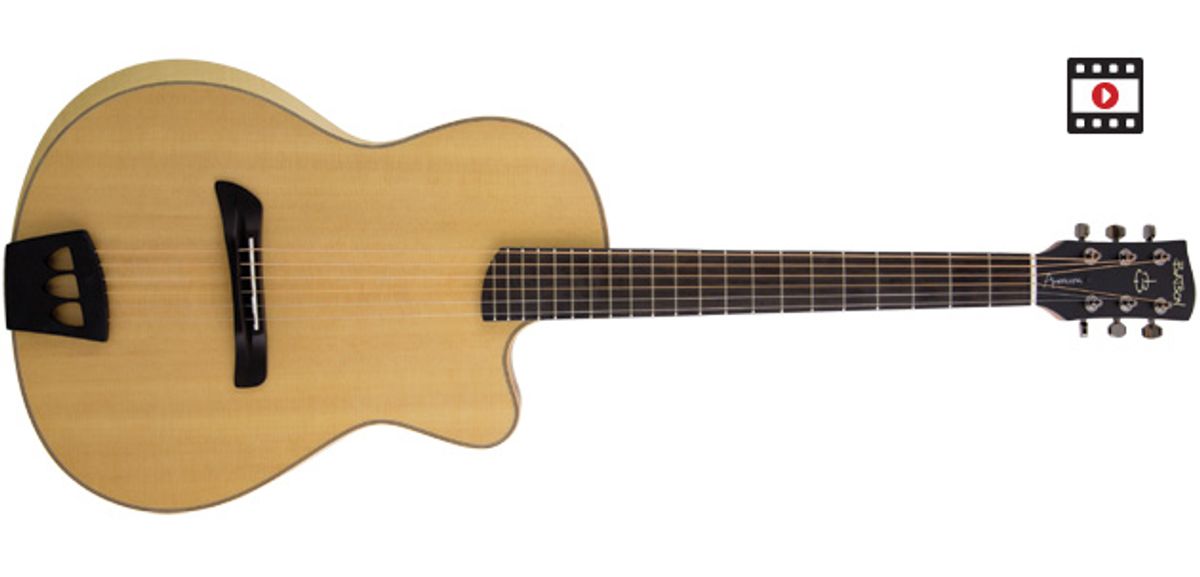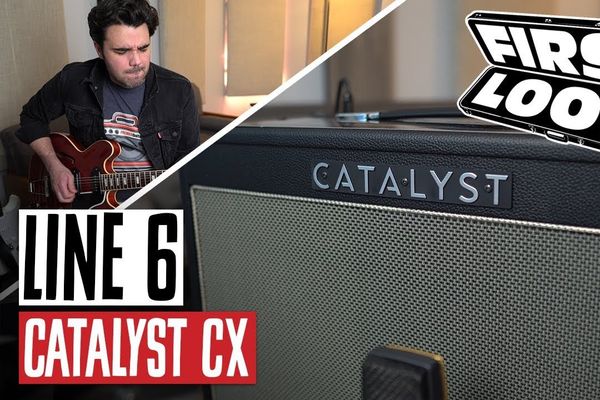A Nashville guitar designer delivers a lower-price boutique spin-off.
The first thing you’re likely to notice about Batson’s GC22 is what’s missing. But the lack of a soundhole on top is just one interesting design detail that makes the GC22 look so different. From the archtop-inspired tailpiece to the cantilevered fretboard, this new, more affordable Batson cuts a striking figure. And just a few chords reveal that the design quirks aren’t just for show. The GC22 is a vibrant and very balanced-sounding flattop that’s extremely satisfying to play.
Lattice is More
Cory Batson is an engineer turned luthier based in Nashville. He started the guitar company that bears his name in 1997. Batson’s engineering instincts and love of constructive tinkering led to some unorthodox designs—most notably a lattice bracing system meant to enhance resonance. Batson made each of his guitars by hand, but they sold for as much as nine grand a pop. So like a growing number of guitar makers, Batson unveiled a line of instruments designed in his workshop and made in Korea. They boast most of the same features as his original U.S.-made guitars—including the lattice bracing system—but sell for a fraction of the price.
Design and Execution
The GC22 is essentially designed around compact grand concert (or 00) dimensions. It’s got a Venetian cutaway that enables easy access all the way up to the 21st fret. The tonewoods include a Sitka spruce soundboard and solid mahogany back, sides, and neck. The design is ornamentally enhanced with flamed maple binding and practical touches including an armrest bevel. But even with these inclusions the design looks and feels almost minimalist.
For the most part, our GC22 is a high-quality, well-built instrument. The frets are smoothly crowned and polished; the body’s curves are cleanly articulated by binding that is flush and tidy. The body interior is somewhat less immaculate. You can see bracing and kerfing that could’ve been more completely sanded, for instance. There are also a few subtle tooling marks on the fretboard. That said, these are superficial details that have no impact on sound or performance.
Spreading Sound
In lieu of a soundhole in the top, the GC22 has a soundport on the side of the bass bout. This feature—first seen on boutique guitars and now on instruments at all prices—is designed to make the full spectrum of the guitar’s output more audible to the player. It really works on our GC22. I felt positively enveloped with a wall of sound when I played it.
The Batson is easy to play thanks to its comfortable C-shaped neck and low, buzz-free action. I received our test model with a perfect setup that remained intact despite a journey through multiple, and very different, climates.
Ratings
Pros:
Excellent harmonic balance. Unorthodox design features yield audible differences.
Cons:
More affordable than earlier Batsons, but still a touch expensive.
Tones:
Playability:
Build/Design:
Value:
Street:
$1,599
Batson Guitar Co. GC22 Americana
batsonguitars.com
The GC22’s most immediately audible virtues are its balance and clarity. The bass register is rich but not overpowering, the mids are impressive, and the treble output is crystalline and not at all harsh. Thanks perhaps to the tailpiece, the guitar has a detectible hint of succinct archtop character that’s most apparent when you play percussively or with chopping-style strums. But it also has very healthy resonance and sustain—qualities that aren’t always a given for a guitar with such snappy responsiveness.
The GC22’s harmonic balance does, at times, add up to a neutral voice. Depending on your playing style, this could be a good thing. The transparency enables you to communicate any musical idea clearly and rewards great technique in any musical approach. But if you’re, say, a blues fingerstylist, that lack of husky tone coloration might be a problem.
Speaking of fingerstylists—with its 1.75” nut and lack of a pickguard, the GC22 is clearly designed with the fingerpicker in mind, and it’s great for this approach, given its resonance and sensitivity to pick-hand nuances. It sounds just as good in standard tuning as it does in DADGAD or open C, and the guitar’s 21:1 Gotoh machines make it a cinch to move between tunings. The guitar also responds superbly to the plectrum. Single-note lines have an impressive attack and presence, and the guitar has a lot of overhead. The sound spectrum never gets too muddled when playing hard.
The Batson Clear Voice under-saddle pickup (which is controlled via soundport-mounted tone and volume controls) sounds really good, too. Plugged into a Fender Acoustasonic amp, the system does a nice job of capturing the guitar’s natural acoustic voice and is resistant to feedback at moderate volume levels.
The Verdict
The acoustic-guitar market has seen the gap between boutique design and affordable price close considerably over the last decade. But it’s nice to see so many unconventional design elements pay real sound dividends in the GC22 Americana. With its thoughtful bracing, tailpiece, and soundhole, and a wide sonic palette, it’s a prime example of how forward-looking guitar design is becoming more accessible than ever.
Watch the Review Demo:

